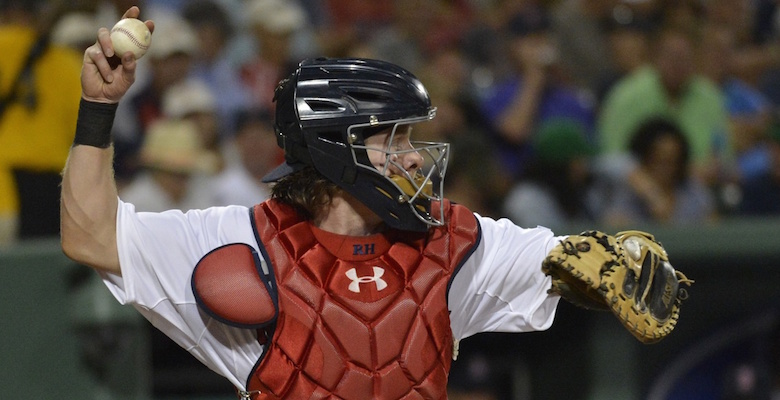Looking back at the offseason, there was an awful lot of focus on the Red Sox’s catcher position. It’s kind of surprising given all of the powerful bats in the lineup and the frightening rotation being thrown out there. A deeper look into things allows it to make much more sense, though. Because of those powerful bats and the frightening rotation, the Red Sox both could and needed to go defense first behind the dish.
Then, Christian Vazquez needed Tommy John surgery and the plan was ruined was before it even started. Trading Will Middlebrooks was supposed to bring in an overly capable backup and a strong mentor for Vazquez. It wasn’t supposed to bring in the starting backstop. That’s how things have worked out thus far, though, and Ryan Hanigan is proving to be a valuable piece for this organization.
It’s clearly not why he’s on the roster, but we’ll start with Hanigan’s offense. In a way, he’s the perfect example of how you can be a valuable hitter without being a good one. His game is extremely clear at this point. He’s not going to hit for average, and he’s not going to hit for power. Instead, he employs plus-plus patience, and he’s put that skill into overdrive this season. The most obvious positive from this is it ups his on-base percentages. This year, for example, he finds himself with a dismal .204 average but a .350 OBP thanks to a borderline-absurd 14.8 percent walk rate.
It’s not just the added on-base percentages that makes Hanigan such a perfect fit here, however. What’s most impressive about him is his ability to wear down pitchers for the other bats in their lineup. He’s averaging over four pitches per plate appearance (the league-average is 3.8) and it just feels like he’s had one eight-pitch at bat every game. So, we have a guy who is wearing down pitchers for the big bats at his worst, and giving them a runner to knock in at his best. Not bad for a no-offense catcher.
In Hanigan, we have a guy who is wearing down pitchers for the big bats at his worst, and giving them a runner to knock in at his best.
Of course, the rest of his game is the reason he is here. Hanigan is an outstanding defensive catcher. Pitch framing is all the rage right now, and it becomes even more important with a Red Sox rotation that likes to pound the bottom of the zone. While he’s not the pitch framer that Vazquez is, Hanigan does help here. Our own Matt Kory has talked about the framing issue with this team much more eloquently than I ever could, so I’ll just point you here and move on.
Even if he’s merely a good pitch-framer rather than an elite one, what Hanigan can do at an elite level is throw out base stealers. If you watched the Red Sox over the last few years, you know what it’s like to watch opponents swipe bags whenever they wanted. Neither Jarrod Saltalamacchia nor A.J. Pierzynski were even average at throwing out runners. Looking back even further, neither were Victor Martinez or late-career Jason Varitek. Hanigan, on the other hand, has been elite in this area throughout his career. Although he had a down year last season, he’s had multiple seasons in his career in which he threw out over 40 percent of base stealers, compared to a league average around 27 percent. Even if we assume he’s aged himself out of the 45+ percent rate, it’s still safe to assume he should remain above average in this area.
Arguably the most important thing has been how the organization has received him. The team seems to genuinely enjoy having him around, and he’s apparently been handling the pitching staff extremely well. The following quote from bullpen coach Dana LeVngie, pulled from here, illustrates why:
“He’s been unbelievable. He’s one of those guys you look up the word ‘catcher’ in the dictionary and his name might be in there. It’s all about the pitcher on the mound, it’s all about trying to get wins and doing the right things. He’s really good. He just moves a little bit more. It’s comfortable for him. He’s getting himself in position, ready for a certain pitch. It might be a tough pitch to handle he’s just preparing for that. He does a really good job sticking pitches.”
What’s most valuable about Hanigan’s respectable performance, however, has been the flexibility he’s allowed them to show with their top prospect. When Vazquez originally went down there were immediately calls to see Blake Swihart in Boston. Given the way Hanigan has played thus far, though, we haven’t heard those calls since. You can be sure if he wasn’t doing what he’s doing, there would be much more pressure on the organization to rush Swihart. Instead, they can give their prospect the development he needs.
At the end of the season, Hanigan isn’t going to sniff any columns written about the most valuable players of the 2015 Red Sox, and for good reason. However, he is the quintessential example of how valuable down-roster players can be. Hanigan provides important patience at the bottom of the lineup, plus defense for a weak pitching staff, and flexibility for the organization to do what’s best for its future. The Vazquez injury looked like it could be an early-season disaster, but Hanigan has alleviated those concerns in short order.
Photo by Tommy Gilligan/USA Today Sports Images
